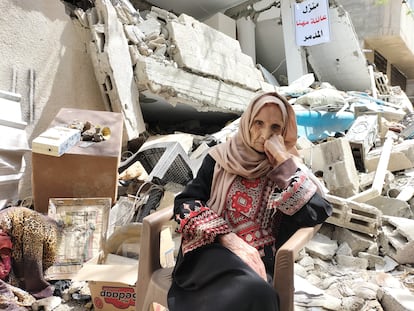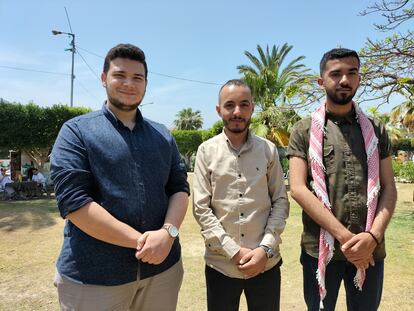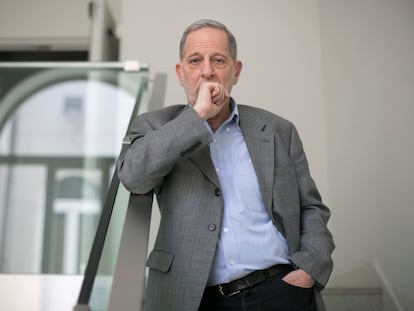75 years after the Nakba: Young and old in Gaza dream of lost homes in Israel
Palestinian identity continues to be marked by exodus and dispossession, with today’s youth longing for the right to return to the hometowns of their grandparents

Said Shamia was eight years old when Egyptian troops hastily withdrew from Hamama, the Palestinian town they were defending, due to the Israeli advance. “They told us they were leaving and that we should too. The adults thought: if they leave, how are we going to stay?” he recalls today from his home in the capital, Gaza, on the 75th anniversary of what Palestinians know as Nakba — “the catastrophe” in Arabic. The term refers to the mass expulsions of hundreds of thousands of Palestinians. It is the reason why Shamia and another almost six million Palestinians are now refugees and why the more than 400 Arab towns in Israel, including Hamama, lie in ruins.
Shamia can’t remember when the Egyptian forces retreated, but it happened in October 1948, halfway through the first Arab-Israeli war. Hamama, with 6,000 inhabitants, had been filling up with displaced people from nearby towns. And Israeli military leader Yigal Allon — who would end up becoming a prominent minister in the Israeli Labor Party — took over Hamama in Operation Yoav, just as he had every other Palestinian town in previous offensives, his goal being to ensure that there was no Palestinian population to the rearguard of the Israeli troops.
Like so many other families, Shamia’s thought that they would be back in a matter of days. That’s why they loaded a camel with “all the food that could fit,” but did not take any goods. He headed with hundreds of other Palestinians towards nearby Al Maydal, today the city of Ashkelon. But the aerial bombings convinced them to continue south, to Hiribya, another town that has been wiped from the maps today, and from there to Gaza. “We rested a couple of days at each site in the hope that the Arab armies would return, and we would go back to our town. Some men went to Hamama to get more food and never returned. It’s not it is like now, where there is television. We didn’t know what was happening,” he says.

“What was happening” is that the Israeli forces — which were better organized and fighting what they considered an existential battle three years after the Holocaust —continued to rack up victories. In 1949, they signed armistices with the Arab countries and Shamia remained a refugee in Gaza, which was then in Egyptian hands.
Some 750,000 Palestinians — two-thirds of those living in the territory that had just become Israel — suffered the same fate. They ended up in Jordan, Lebanon, Syria, Gaza and the West Bank. In 1948, the U.N. General Assembly issued Resolution 194, which stated that “refugees wishing to return to their homes and live at peace with their neighbours should be permitted to do so at the earliest practicable date.” But hundreds of Palestinians were killed when they clandestinely crossed the border, and Israel partially or totally destroyed the more than 400 towns in which they lived. Today, national parks, agricultural cooperatives and municipalities stand where they once were. In cities such as Haifa, Jaffa, Jerusalem and Ramla, their homes were nationalized and were used to house the Jews who arrived — in many cases, under duress — from North Africa and the Middle East to the fledgling state of Israel. The largest and most elegant houses are now being sold as luxury residences.
The 750,000 Palestinian refugees now number close to six million, if their descendants are taken into account. And the word Awda — meaning the “right to return” — appears at the entrance of their camps next to the image of a key, which is another symbol of their lost homes.
But collective will is one thing, and political reality another. The question of the right to return has only been raised in the peace negotiations for a symbolic number of refugees. Last week, Palestinian President Mahmoud Abbas told the U.N. that he has the right to return to his hometown Safed, but a decade ago, he opposed the idea of the right to return, arguing that it was “illogical” to ask Israel to receive even a million refugees. Israel believes that the return of the refugees would be political suicide for the Jewish state, as it would lose its demographic majority. Israel also argues that the Nakba is simply the consequence of the Arab world’s refusal to support the U.N. partition plan for Palestine under the British Protectorate. Between November 1947 — when the plan was presented, and hostilities between Jewish and Arab forces began to rise — and the formal start of the war, in May 1948, up to 300,000 Palestinians fled or were expelled.
Shamia recounts that he harbored hopes of returning to Hamama until Israel’s overwhelming victory in the Six-Day War (1967), when his father burned his property deed in a rage. He later visited the ruins of his village several times. This was back at a time when thousands of Israelis and Palestinians crossed daily from one side of Gaza to the other. He wanted to “feel the smell again” and show it to his children. “I remember picking up a fig and feeling like I had stolen it. Can you imagine that?” he asks.
Intisar Muhna also lived through the Nakba. She is 95 years old, and symbolizes a more recent and political concept called Al Nakba Al mustamirra — the Nakba continues. “The same thing is happening again. They bombed the school in my town, they killed my brother, and now they follow us wherever we go,” she says, standing in front of the rubble of her house in the Yarmouk neighborhood of Gaza City. It had just been destroyed in an Israeli bombing during the latest escalation of violence with Islamic Jihad. She is alive because the Israeli army warned her by phone to leave before the strike.
Muhna talks more about the past than the present. She likes to recall that her father was the mayor of her hometown, Al Masmiya Al Kabira, and that he had money, and he hid militiamen during the war. “We heard so many attacks that were so close to us that he came to the conclusion that we had to leave,” she recalls. As they were a wealthy family, they did not escape by donkey or on foot, but in a car that they used to keep “for weddings or special occasions.” “We were so naive to think that we would be returning soon…,” she says.
Identity
The Nakba is the episode that has most defined Palestinian’s identity as a dispossessed people. It is buttressed by the fact that while Palestinian refugees cannot return to their homes, anyone with at least one Jewish grandparent has an almost automatic right to settle in Israel and obtain nationality. For this reason, the Nakba is also alive in the minds of young people, who can only see the lost homes of their elders online and are aware of the Israeli military strength 75 years later.
That’s the case for Shahd, a 17-year-old who posts videos on social media about “the beautiful side of Gaza.” As she grew up in the Gaza Strip under the blockade, she has never been able to visit Ramla, the city in Israel where her grandfather comes from. She says her grandfather still keeps the key to his house in Ramla “in a special box.” “It is true that I was born here, but I know that originally I am not from here. And when someone says the word Nakba, it reminds you of where you come from,” she explains. Even so, she believes that the elderly “think more about the past” and the young, like her, are “more concerned about the current situation.”
Wassim Abu Nada, Rami Algaramar and Firas Al Khatib also have refugee status. They are in their twenties, and coming from their mouths, “the right to return” sounds like the conquest of a lost paradise — particularly given the reality they face in Gaza, a territory that is overcrowded, impoverished and has been under a blockade for almost two decades. Two thirds of the 2.1 million inhabitants in Gaza are refugees.
As they drink coffee in a park in front of the Islamic University, the three say that they believe that one day Israel will be defeated, that it will disappear from the face of the Earth, and they will return to the towns of their grandparents, even if only rubble is left. This is the kind of irredentism that Israel says is proof that the Palestinians think that the Jewish state is just a mere parenthesis in the history of the Middle East — and not a reality that is here to stay.
“Since we were little, we have grown up knowing that we are refugees, we have lost our land and we will return one day,” says Abu Nada, whose grandmother keeps the key to her house in Dimra in a box of chocolates. Kibbutz Erez rises above that village today, barely a mile from the ultra-protected border crossing that has made it impossible to reach what is just a stone’s throw away.

The stories are passed from generation to generation. Al Khatib recounts that, when he was a teenager, he would listen to his grandfather talk about Arab Suqrir, a small village that existed on the shores of the Mediterranean, and he would think: “Here he goes again with his little war stories.” “He told me everything: about the neighbor lived in such-and-such house and the other that lived in one a house away... Now I record it all down, as a personal and historical record,” he says.
Algaramar is the most political and least personal of the three. He wears the typical red and white kufiya, which identifies militant Marxists, and quotes George Habash, the founder of the Popular Front for the Liberation of Palestine. “I don’t want money or apologies from Israel. I want my land and to move as I please: to have breakfast in Jerusalem and dinner in Acre. Someday we will be stronger than them.”
Sign up for our weekly newsletter to get more English-language news coverage from EL PAÍS USA Edition
Tu suscripción se está usando en otro dispositivo
¿Quieres añadir otro usuario a tu suscripción?
Si continúas leyendo en este dispositivo, no se podrá leer en el otro.
FlechaTu suscripción se está usando en otro dispositivo y solo puedes acceder a EL PAÍS desde un dispositivo a la vez.
Si quieres compartir tu cuenta, cambia tu suscripción a la modalidad Premium, así podrás añadir otro usuario. Cada uno accederá con su propia cuenta de email, lo que os permitirá personalizar vuestra experiencia en EL PAÍS.
¿Tienes una suscripción de empresa? Accede aquí para contratar más cuentas.
En el caso de no saber quién está usando tu cuenta, te recomendamos cambiar tu contraseña aquí.
Si decides continuar compartiendo tu cuenta, este mensaje se mostrará en tu dispositivo y en el de la otra persona que está usando tu cuenta de forma indefinida, afectando a tu experiencia de lectura. Puedes consultar aquí los términos y condiciones de la suscripción digital.
More information
Archived In
Últimas noticias
Maduro counterattacks Trump with rhetoric and announces downing of nine drug trafficking aircraft
‘Ecce Homo’: The miraculous disaster that made a small Spanish town famous
Return to sex testing at the Olympics: IOC edges closer to banning transgender women
Trump escalates conflict with Venezuela with the start of covert operations
Most viewed
- Sinaloa Cartel war is taking its toll on Los Chapitos
- Oona Chaplin: ‘I told James Cameron that I was living in a treehouse and starting a permaculture project with a friend’
- Reinhard Genzel, Nobel laureate in physics: ‘One-minute videos will never give you the truth’
- Why the price of coffee has skyrocketed: from Brazilian plantations to specialty coffee houses
- Silver prices are going crazy: This is what’s fueling the rally











































